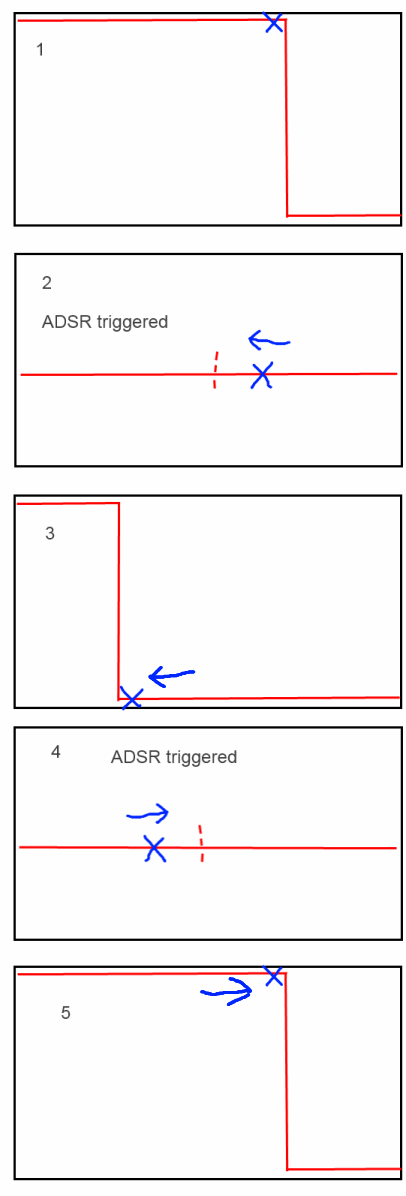unix-guy
Master of RTFM
Drat, I thought that might work out for you.
Drat, I thought that might work out for you.

I'll read this again tomorrow when my eyes and brain are fully operational... But the sound clip does show it workingHere's an LFO solution done on the Axe II. This has the "real" pick detector ADSR plus an LFO B Phase modifier, which I don't think is assignable in the usual way on the III.
The LFO is square type and stopped. When triggered the ADSR briefly drops LFO depth to 0% while LFO 1B controls LFO Duty% and B Phase, plus bypass state of the filters panned L/R. The image below might explain it better. LFO B value (height of blue X) determines both its own horizontal position (B phase) and where the waveform discontinuity occurs (duty%). Lower values move both to the left with the X having a narrower overall range. A small amount of damping on the B Phase modifier lets it catch a ride up/down on the opposite chunk of the waveform before settling in position for the next trip.

https://dl.dropboxusercontent.com/s/9kfafoz7djb4y71/lfopan.mp3
Nice!!Here's an LFO solution done on the Axe II. This has the "real" pick detector ADSR plus an LFO B Phase modifier, which I don't think is assignable in the usual way on the III.
The LFO is square type and stopped. When triggered the ADSR briefly drops LFO depth to 0% while LFO 1B controls LFO Duty% and B Phase, plus bypass state of the filters panned L/R. The image below might explain it better. LFO B value (height of blue X) determines both its own horizontal position (B phase) and where the waveform discontinuity occurs (duty%). Lower values move both to the left with the X having a narrower overall range. A small amount of damping on the B Phase modifier lets it catch a ride up/down on the opposite chunk of the waveform before settling in position for the next trip.

https://dl.dropboxusercontent.com/s/9kfafoz7djb4y71/lfopan.mp3
Here's an LFO solution done on the Axe II. This has the "real" pick detector ADSR plus an LFO B Phase modifier, which I don't think is assignable in the usual way on the III.
The LFO is square type and stopped. When triggered the ADSR briefly drops LFO depth to 0% while LFO 1B controls LFO Duty% and B Phase, plus bypass state of the filters panned L/R. The image below might explain it better. LFO B value (height of blue X) determines both its own horizontal position (B phase) and where the waveform discontinuity occurs (duty%). Lower values move both to the left with the X having a narrower overall range. A small amount of damping on the B Phase modifier lets it catch a ride up/down on the opposite chunk of the waveform before settling in position for the next trip.
https://dl.dropboxusercontent.com/s/9kfafoz7djb4y71/lfopan.mp3
Here's an LFO solution done on the Axe II. This has the "real" pick detector ADSR plus an LFO B Phase modifier, which I don't think is assignable in the usual way on the III.
[...]
@Bakerman, your recording is wild!
I have made an effort to reproduce your solution on the III and am unable to. I follow the drawings and your explanation, but I'm unable to map it to the III. Is the assignability you mention a limitation to achieving this on the III?
The guitar bits in end portion of "What Is And What Should Never Be" comes to mind of a manually-panned example.So each burst of input is what forces the ping pong? do you have an audio example of this? I’ve only ever heard LFO style panning where it’s a regular pattern, not based on when you play. Would be cool to hear.
@Bakerman - the luminary of LFO logic....Here's an LFO solution done on the Axe II. This has the "real" pick detector ADSR plus an LFO B Phase modifier, which I don't think is assignable in the usual way on the III.
The LFO is square type and stopped. When triggered the ADSR briefly drops LFO depth to 0% while LFO 1B controls LFO Duty% and B Phase, plus bypass state of the filters panned L/R. The image below might explain it better. LFO B value (height of blue X) determines both its own horizontal position (B phase) and where the waveform discontinuity occurs (duty%). Lower values move both to the left with the X having a narrower overall range. A small amount of damping on the B Phase modifier lets it catch a ride up/down on the opposite chunk of the waveform before settling in position for the next trip.

https://dl.dropboxusercontent.com/s/9kfafoz7djb4y71/lfopan.mp3
@Bakerman 's "hack" still blows me away and can't map it to the III. If anyone knows the ins and outs of the controllers it's you, @Admin M@ ! Does it seem obvious to you? Would you be able to port the patch to the III within seconds? Because it's already taken me at least an hour and I still can't get it to work!I think it was one of my old Lexicon units that had an envelope (or MIDI) triggered flip-flop mod source. That was really cool and did exactly what you're describing.
It would be lovely to get it as a built-in type.I think it was one of my old Lexicon units that had an envelope (or MIDI) triggered flip-flop mod source. That was really cool and did exactly what you're describing.
My H3000SE with Mod Factory had a filter pan which was a triggered wah pan, one of the coolest effects ever. Tried to replicate it on the axe with no success…:-(I think it was one of my old Lexicon units that had an envelope (or MIDI) triggered flip-flop mod source. That was really cool and did exactly what you're describing.
